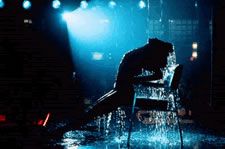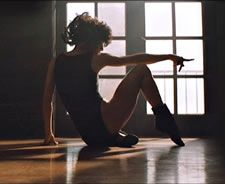
Water used to emphasise the lines of the dance
Flashdance has an acceptable but unexceptional storyline about a woman making it in a man’s world, which features plenty of eye candy for men. But it is the dances that make people see it again and again. Flashdance boasts the second highest grossing box office of any dance movie. Many of the dances were cinematic invention, achieved by award-winning editing that fuses multiple dance-doubles into a single lead character. But this never dimmed its appeal. How do the dances achieve such tremendous impact?
The role of choreographer is traditionally under-recognised in films, even uncredited. The way dances are constructed, often from several sources, means there are sometimes several ‘choreographers’, all under the control of a dance director. Choreographers are aware of the use of space, but choreographing for film requires an additional feeling for how the camera sees that space. These two can be radically different, as examined in our article Let’s Dance. The choreographer/dance director develops dances and production numbers that highlight the abilities of stars and specialty dancers in the slots assigned by director and writers. These, in turn, will strengthen plot development. Or provide slots purely to entertain (as with our film’s ‘dancing’ traffic cop or its street breakdancers).
Additionally, ‘choreographing for the camera’ enables transitions of time and space, or other movement physically impossible for the live dancer. As Scheurer wrote: “By choreographing the camera as such the filmmaker and choreographer give it the stature of a participant in a dance. Through movement, or compression and expansion of the visual image, or editing, the filmmaker is able to anticipate and embellish movement and, ultimately, control the message being communicated in the dance.”
Several cameras running at once are needed so that cuts maintain not only continuity but keep the beauty of the movement and sense of perfect overall harmony.
The idea of 'flashdancers' comes from some bars in the Vanouver area. Girls there didn’t dance to strip, they danced because they wanted to be dancers. They had their own costumes and their own dance routines. Tom Hedley, who drafted the first script, called them flashdancers.
The first attempts to create a dance for Jennifer Beals used a New York dance teacher. They looked promising but didn’t have the sexy, visceral impact required for the movie. Dancer Jeffrey Hornaday was enlisted to design the steps, even though he had never choreographed before. He insisted that a professional dance double was required, getting reassurance from director Adrian Lyne that any technical hurdles could be overcome.
Costume, lighting and sets have evolved with dance. But Lyne brought extra experience from the worlds of advertising and music video. Smoke machines are frequently prominent in the film, but also used subtly to create a pastel look in the loft where Alex rehearses. Pastels are traditionally used by artists who want to capture the fleeting visual and emotional effects of a world in constant motion, but also the immediacy of a momentary gesture or luminous mood.
Visual lines of the dances are emphasised using water and judicious lighting. Water conveys an attractive sheen and visual appeal, even in the steelmill. But water is notoriously hard to capture well on film. For Gene Kelly’s famous Singin’ In The Rain scene, milk had to be added to the ‘rain’ so it would show up properly.
Lyne uses a different approach. He positions a camera at the back of the stage in the opening ‘flashdance’. Spotlights shine into it almost blindingly during the dramatic water deluge. When it hits the dancer, she is shown in silhouette. The cascade and droplets stand out clearly in the spotlights’ glare, while the reflection of water on skin further eroticises the dancer’s body. As she throws her head forward, her hair jets an arc of water, continuing the dance-line and emphasising the move. An almost identical effect will be achieved in Lois Greenfield’s famous 1988 still photograph of dancer Ashley Roland. There, it is not just the shape of the body but the flying tresses of hair that communicate sudden and powerful downward motion.
Cynthia Rhodes, who dances the Manhunt number, is a trained gymnast as well as dancer. This opens up new possibilities for choreographer Hornaday. He can now include backflips and dramatic gestures such as running up a wall. At one point, when the camera is again placed at the back of the stage, the flare of the lights not only silhouettes the dancer’s body, but lengthens her arms with resultant shadows, suggesting even more movement than there is.
The Mawby’s Bar dance numbers are performed in confined stage space, ideal for cinema. The camera can remain motionless for longer, so our entire attention is focussed on motion created by the dancer.

The jazz-dance style, on which many of the moves are based, is ideal for dancing in a small space. Choice of dance styles has another important advantage for Flashdance. Whether jazz-dance, breakdance or the vague nods to classical ballet iconography. Unlike say, Dirty Dancing, or the disco style of Saturday Night Fever, these styles haven’t aged. Jazz, developed by pioneers such as Katherine Dunham, quickly became an idiom of ongoing development under the likes of Bob Fosse. It would maintain popularity in films such as Chicago, and continuously successful West End productions to the present day. Jazz-dance is highly charged and technically brilliant. It also has strong, sharply defined movements that show up well, creating impact whether on cinema screen or television.
Breakdance also appears prominently in the film and shares many of the above characteristics, while ballet flourishes when well-incorporated. Whether in the hip-hop contrasts of Save The Last Dance, the equally fanciful Billy Elliot, an overblown Center Stage, or the forthcoming real life drama, Only When I Dance.
With Alex’s audition scene, Hornaday speaks of "hitting certain emotional beats". The film editing goes beyond synching the cuts to the music. When Alex stumbles at the start of her audition, the moment has been foreshadowed by Jeanie’s fall at the ice rink. This striking visual recurrence subliminally raises the volume on what we are already feeling, since the emotion has been ‘primed’ in the earlier scene.
The audition dance uses a girl gymnast (Sharon Shapiro ), a male breakdancer (Crazy Legs Richard Colón), the main dance double (Marine Jahan) and actress Jennifer Beals. All four are fused into a single cinematic dance character, played by Beals. Skilful use of long shots, costume and careful lighting achieves the required suspension of disbelief by making the seams invisible.
The dance moves themselves seem partly chosen for their technical virtuosity and also for their ability to express feelings or ideas kinetically. From a technical point of view, emotion is particularly keyed by the shape and movement of the diaphragm. When we see Alex crouched after the stumble, her head and diaphragm close in on herself. We instinctively associate this posture with a sense of sorrow. In contrast, when she throws her head back and expands her diaphragm, especially in leaps and arches of the body, we associate that movement with exhilaration and joyous experience. The dance leads the audience from a low point (associated with Jeanie’s despair at the ice rink – will Alex also despair?) to a supreme emotional high. Expansive, joyous leaps are reinforced immediately afterwards. We unexpectedly cut forward in time, yet still within the song, as Alex leaps into the arms of her lover.
A similar analysis can be applied to lesser scenes. When Alex rescues her friend Jeanie from Zanzibar, the latter is lying on her back (a recognisable attitude of submission). Even though a similar posture is glimpsed in the gym workout. The difference is that, in the gym choreography, the diaphragm is expanded. In Zanzibar, the scene where Jeanie has lost hope, it is collapsed.
These ‘emotional contents’ of posture were probably first observed, analysed and recorded around the start of modern dance. By another woman fighting for acceptance in a man’s world – dance pioneer, Isadora Duncan. And who was as equally unyielding to bad press as Flashdance seems to be. The Boston Globe called Flashdance, “the end product of energy being released by an essentially lyrical temperament.” As Alex punches the air triumphantly in her climactic dance audition, she performs a ritual gesture of female empowerment for every young woman everywhere.





















